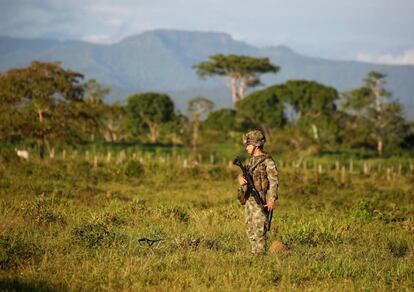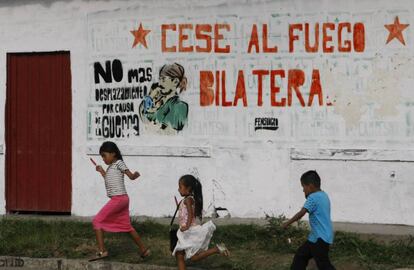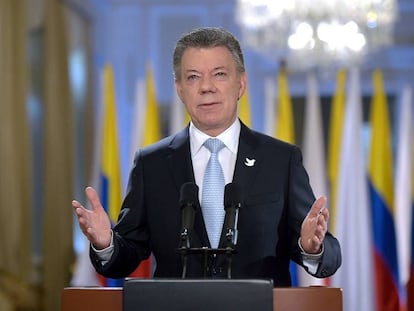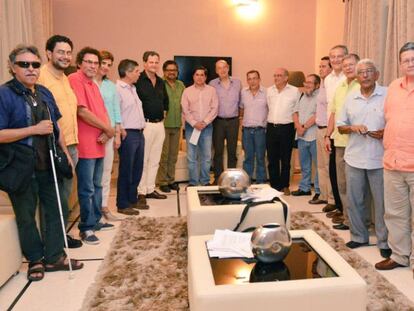Colombian government follows the FARC guerrilla’s money trail
Prosecutors have seized over $100 million in assets so far this year, within national territory and abroad

The FARC guerrilla group’s transition to civilian life following more than 50 years of armed conflict in Colombia means more than just handing over its weapons. It also means breaking with the past in financial terms.

Colombian authorities are intensifying efforts to follow the trail of the insurgency’s millions of dollars’ worth of assets, which are stashed within national territory and abroad.
Prosecutors say that the value of seized assets in 2017 is upwards of $100 million, and they have announced an international cooperation plan to locate capital that former combatants are concealing outside Colombia.
Authorities have set up a legal cooperation mechanism with countries in Central America and with the US State Department
“In just these first few months of the year we have already managed to seize assets worth 300 billion pesos [around $105 million] and we are making progress on several processes concerning extinction of domain,” said Attorney General Néstor Humberto Martínez, alluding to the confiscation of assets linked to illicit activities.
These operations are decisive for the implementation of the accords between the Colombian government and the FARC, because one of the executive’s decrees, issued in late May, stipulates that any funds raised in this way will be allocated to the victims.
Before August 1, the guerrilla group will have to present the United Nations with an inventory of its possessions. And its more than 900 arms caches will need to be dismantled before September.
“The goods and assets included in the inventory will be used toward the material reparation of the victims of the conflict,” reads the text.

During the war, the FARC accumulated “thousands of urban real estate properties, thousands of rural properties, commercial premises, cooperatives, cash, automobiles,” said the attorney general, who also warned about the existence of assets abroad.
As a result, authorities have set up a legal cooperation mechanism with countries in Central America and with the US State Department. One recent operation involved the confiscation of $450,000 concealed in a bank in Costa Rica, a sum that Colombian prosecutors attributed to the FARC. Additionally, 3,400 assets have been seized following court orders.
Three “serious violations”
Meanwhile, Colombia’s peace process oversight body – the Monitoring and Verification Mechanism – has detected three “serious violations” of the accords in the last month.
According to a report released on Tuesday, the first incident took place on May 10, when a FARC member allegedly made an attempt to sexually assault two minors in the rural area of Vidrí, in the Antioquia department. The High Commissioner for Peace of the Juan Manuel Santos administration said that this incident bears no relation with the weapons handover and that it is “a case for the ordinary courts.”
The second incident involved shots fired by guerrilla members against an army patrol that entered an area filled with combatants. One of the bullets wounded a military officer’s left leg. The third incident was an airspace violation by a helicopter that entered the transition area of Caño Indio, in the northern portion of the Santander department.
English version by Susana Urra.
Tu suscripción se está usando en otro dispositivo
¿Quieres añadir otro usuario a tu suscripción?
Si continúas leyendo en este dispositivo, no se podrá leer en el otro.
FlechaTu suscripción se está usando en otro dispositivo y solo puedes acceder a EL PAÍS desde un dispositivo a la vez.
Si quieres compartir tu cuenta, cambia tu suscripción a la modalidad Premium, así podrás añadir otro usuario. Cada uno accederá con su propia cuenta de email, lo que os permitirá personalizar vuestra experiencia en EL PAÍS.
¿Tienes una suscripción de empresa? Accede aquí para contratar más cuentas.
En el caso de no saber quién está usando tu cuenta, te recomendamos cambiar tu contraseña aquí.
Si decides continuar compartiendo tu cuenta, este mensaje se mostrará en tu dispositivo y en el de la otra persona que está usando tu cuenta de forma indefinida, afectando a tu experiencia de lectura. Puedes consultar aquí los términos y condiciones de la suscripción digital.
More information
Archived In
Últimas noticias
From Andorra to Gibraltar, a black market for Ozempic exploits its success: ‘They’re the most sought-after products in the world’
Magnets in their heads: How some animals guide themselves using the Earth’s magnetic field
From Hungary’s Orbán to Chile’s Kast: How Trump helps turbo charge the far right
From safe-haven investment to geostrategic weapon: Who owns the most gold and where are the bars kept?
Most viewed
- Why we lost the habit of sleeping in two segments and how that changed our sense of time
- Charles Dubouloz, mountaineering star, retires at 36 with a farewell tour inspired by Walter Bonatti
- Venezuela faces its most tense Christmas yet
- CBS in crisis after pulling a report on Trump’s deportations to El Salvador (which later leaked online)
- Trump’s obsession with putting his name on everything is unprecedented in the United States










































